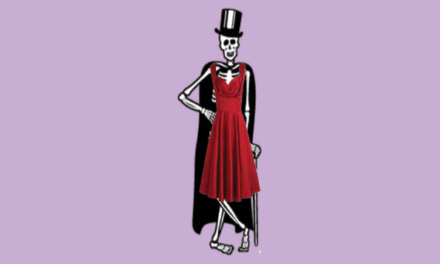Jai Barnett (24C) envisions a vibrant campus life, one bursting with color and fluttering fabric. The main contributor: Emory University’s own color guard club.
Color guard, Barnett said, stands alone, separate from a marching band. A color guard ensemble dances to music, using flags or metal sabers, to perform cohesive choreography.
Barnett said they were motivated to start the club even before arriving at Emory in 2020. COVID-19 stalled color guard operations for nearly two years, but a full return to campus has allowed Barnett to launch the club with the support of their faculty adviser, George Staib, a professor of practice in the Emory Dance & Movement Studies Program.
Staib has been involved with color guard since he was in high school and continues to direct groups in Atlanta and other areas of Georgia. He said Barnett is one of many students who expressed an interest in starting a color guard group at the University, but Barnett was the first to follow through with the initiative.
“I’m just thrilled,” Staib said.
Barnett became involved with color guard in high school in Rossville, Georgia, when they joined the winter guard team, an indoor version of color guard. During Barnett’s senior year, they performed for Eunoia Independent Winterguard, which competed against well-known groups in Atlanta.

Jai Barnett (24C) is the founder of Emory Color Guard.
“In that group, I learned a lot more techniques in [modern contemporary and jazz] and then was inspired to come to Emory as a dance major,” Barnett said.
A color guard club at Emory will allow Barnett to continue exploring dancing, teaching and choreographing, and by starting the club, they want to allow others to have a similar opportunity to their own.
The opportunity is multi-faceted. Barnett said the community and culture of color guard brings together dance, self-expression and individuality to allow people to learn how to flow freely with who they are.
Color guard has also helped them understand their sexuality and personal identity.
“Wearing makeup and doing a lot of extravagant things was very attractive to me, almost like a kid in a candy store,” Barnett said. “I just loved all of it.”
Barnett believes color guard can stand as another opportunity for the University’s community to become more integrated and close-knit, uniting dancers and non-dancers in a lighthearted, extravagant space, similar to that of a circus, they said.
“I feel like what this is going to do is excite more people to enjoy dance by offering new forms that people are not aware of,” Barnett said.
Atlanta is home to well-established color guard groups like Reverie, Paramount and Georgia State University’s team, yet many seem unfamiliar with the art form, Barnett said.
Staib is hopeful for a debut performance from the club by the end of the semester to create interest for potential performers and community members in the fall.
“Even though it’s been around for 40 plus years, it still flies under the radar for many people,” Staib said. “I love that Jai is interested in showing the … contemporary version of what we do.”
Looking ahead to campus events, Barnett hopes the club will make appearances in the University’s annual Homecoming Parade this October. Many color guard teams perform at amusement parks, parades and other community events as well.
Secretary Audrey Lu (24C) believes the club’s collaborative and artistic nature will contribute to the University’s school spirit, which she said is lacking.
“Color guard … can bridge a lot of different fields of performance art,” Lu said. “You have your dancers, your choreographers, the composers, the people putting the music together, the people who design costumes.”
However, until the color guard club is chartered, necessary supplies and spaces are not available to the team.
“You need tall ceilings, and that’s not so easy to come by,” Staib said.
The club meets once a month until funding is obtained, mastering dance fundamentals and planning for the future with assistance from Staib and Cynthia Church, a costume designer in the Emory Dance program.
The club’s first meeting was attended by about 15 enthusiastic students, and Barnett’s instruction began with basics like flexibility and dance fundamentals to provide all members with the same technical foundation.
“I do think that it’s a comfortable and accessible way to get involved,” said Lu, who is new to color guard and dance herself.
Staib said color guard rehearsals are focused and process driven, perfecting a single four-to-six-minute long show over a period of four to five months.
“It is focused attention to one choreographic idea, rather than being frivolous, and it just gets better and stronger with each performance,” Staib said. “It really builds upon one idea.”
Staib views color guard as a unique blend of physicality, musicality and dance.
“It really is a beautiful fusion of music movement, and what we call it in the field is pageantry,” he said.
Oli Turner (she/her) is from Manchester, Massachusetts, majoring in English & Creative Writing and minoring in Rhetoric, Writing, & Information Design. Her work has appeared in Atlanta Magazine, Boston Hassle, and the Manchester Cricket. She co-hosts the Wheel's arts & entertainment podcast, Clifton Culture, which spotlights student artists at Emory. Outside of the Wheel, she serves as Vice President of WMRE, Emory's student-run radio station. When she's not writing, editing, or DJ-ing, you can find her at the nearest DIY show scoping out local live music.





